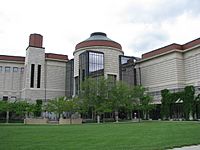Minnesota History Center facts for kids
 |
|
 |
|
| Established | 1992 |
|---|---|
| Location | 345 W. Kellogg Boulevard Saint Paul, Minnesota, United States |
| Type | Historical society |
| Public transit access | Bus: 16, 21, 94 |
The Minnesota History Center is a cool museum and library in Saint Paul, Minnesota. It's the main place for the Minnesota Historical Society, which helps us learn about Minnesota's past. You can find it on Kellogg Boulevard, between the Mississippi River and the Minnesota State Capitol.
Before this building opened in 1992, the Minnesota Historical Society (MNHS) was in a different building. That building is now called the Minnesota Judicial Center. Even before that, MNHS was in the basement of the State Capitol building.
The History Center is a busy place! It hosts many different events. These include concerts, dance shows, and talks. Many groups use the center for meetings and parties. A huge number of students visit every year. About 75,000 schoolchildren come to learn about history.
Contents
Exploring the Center's Design
The Minnesota History Center has a special design. The building was planned by a company called Hammel Green and Abrahamson (HGA). They looked at famous Minnesota buildings for ideas. These included Fort Snelling, the St. Paul's Cathedral, and the Minnesota State Capitol.
One person involved in the planning had a great idea. They wanted a place that would make people curious. A place that would help them imagine the past. They hoped it would be full of people from morning until night. A truly important place for culture and learning.
How the Building Looks
The History Center opened in October 1992. It took ten years to plan and almost three years to build. The building has a main dome in the middle. Two wings stretch out from it, making an L-shape. The front of the building faces the Capitol. A big lawn and terrace are on the other side. You enter through large bronze doors on the west side.
Artworks Inside and Out
The building project included money for art. This meant three special artworks were added. They are part of the building itself.
- Charm Bracelet: This artwork is on the floor of the main rotunda. It looks like a broken piece of jewelry. It was made by James Casebere. Each of the ten "charms" shows something important about Minnesota. For example, a tractor for farming. A tepee for the Dakota tribe. A mill building for lumber and flour. These charms help tell Minnesota's story.
- Glass Etchings: You can see glass etchings by Brit Bunkley at the entrances. These are above the doors and in the courtyard. He made special designs on the thick glass. They show different symbols related to history.
- Minnesota Profiles: Andrew Leicester created these terra cotta columns. They stand where an old street, Summit Avenue, used to cross. Each column looks like a native tree. They also have sculpted faces of 140 volunteers.
What You Can Find Inside
The Minnesota History Center is one of 26 places run by the Minnesota Historical Society. It's the main office for the Society. It also holds many historical items. There's a huge library and a big museum area. The museum has interactive exhibits. These are made by the center or travel from other places. They also have talks and programs about history.
The center has rooms for meetings. There's an auditorium called the 3M Auditorium. You can grab a bite at Café Minnesota. There are also two gift shops and many classrooms.
More than half of the building is underground. This space is mostly used for storage. The Minnesota History Center has over 1 million artifacts! These include old objects, books, photos, and maps. They also have paintings, drawings, and old government papers. All these items are kept safe in the storage areas. Some shelves in storage are over 25 feet tall! The center also has a special lab. Here, experts repair and care for valuable historical objects.
Gale Family Library
Discovering History in the Library
The Gale Family Library is on the second floor of the History Center. It's a great place for anyone to do research. Members of MNHS and other visitors can use its resources. The library has two main rooms. These are the Weyerhaeuser Reference Room and the Ronald M. Hubbs Microfilm Reading Room. The library often offers classes. These classes teach people how to research history and family trees.

